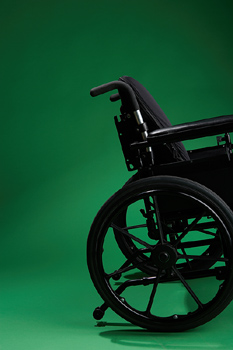Your body is probably home to a chemical called bisphenol A, or BPA. It's a synthetic estrogen that United States factories now use in everything from plastics to epoxies — to the tune of six pounds per American per year. That's a lot of estrogen.

Nicholas D. Kristof
On the Ground
More than 92 percent of Americans have BPA in their urine, and scientists have linked it — though not conclusively — to everything from breast cancer to obesity, from attention deficit disorder to genital abnormalities in boys and girls alike.
Now it turns out it's in our food.
Consumer Reports magazine tested an array of brand-name canned foods for a report in its December issue and found BPA in almost all of them. The magazine says that relatively high levels turned up, for example, in Progresso vegetable soup, Campbell's condensed chicken noodle soup, and Del Monte Blue Lake cut green beans.
The magazine also says it found BPA in the canned liquid version of Similac Advance infant formula (but not in the powdered version) and in canned Nestlé Juicy Juice (but not in the juice boxes). The BPA in the food probably came from an interior coating used in many cans.
Should we be alarmed?
The chemical industry doesn't think so. Steven Hentges of the American Chemistry Council dismissed the testing, noting that Americans absorb quantities of BPA at levels that government regulators have found to be safe. Mr. Hentges also pointed to a new study indicating that BPA exposure did not cause abnormalities in the reproductive health of rats.
But more than 200 other studies have shown links between low doses of BPA and adverse health effects, according to the Breast Cancer Fund, which is trying to ban the chemical from food and beverage containers.
"The vast majority of independent scientists — those not working for industry — are concerned about early-life low-dose exposures to BPA," said Janet Gray, a Vassar College professor who is science adviser to the Breast Cancer Fund.
Published journal articles have found that BPA given to pregnant rats or mice can cause malformed genitals in their offspring, as well as reduced sperm count among males. For example, a European journal found that male mice exposed to BPA were less likely to make females pregnant, and the Journal of Occupational Health found that male rats administered BPA had less sperm production and lower testicular weight.
This year, the journal Environmental Health Perspectives found that pregnant mice exposed to BPA had babies with abnormalities in the cervix, uterus and vagina. Reproductive Toxicology found that even low-level exposure to BPA led to the mouse equivalent of early puberty for females. And an array of animal studies link prenatal BPA exposure to breast cancer and prostate cancer.
While most of the studies are on animals, the Journal of the American Medical Association reported last year that humans with higher levels of BPA in their blood have "an increased prevalence of cardiovascular disease, diabetes and liver-enzyme abnormalities." Another published study found that women with higher levels of BPA in their blood had more miscarriages.
Scholars have noted some increasing reports of boys born with malformed genitals, girls who begin puberty at age 6 or 8 or even earlier, breast cancer in women and men alike, and declining sperm counts among men. The Endocrine Society, an association of endocrinologists, warned this year that these kinds of abnormalities may be a consequence of the rise of endocrine-disruptin g chemicals, and it specifically called on regulators to re-evaluate BPA.
Last year, Canada became the first country to conclude that BPA can be hazardous to humans, and Massachusetts issued a public health advisory in August warning against any exposure to BPA by pregnant or breast-feeding women or by children under the age of 2.
The Food and Drug Administration, which in the past has relied largely on industry studies — and has generally been asleep at the wheel — is studying the issue again. Bills are also pending in Congress to ban BPA from food and beverage containers.
"When you have 92 percent of the American population exposed to a chemical, this is not one where you want to be wrong," said Dr. Ted Schettler of the Science and Environmental Health Network. "Are we going to quibble over individual rodent studies, or are we going to act?"
While the evidence isn't conclusive, it justifies precautions. In my family, we're cutting down on the use of those plastic containers that contain BPA to store or microwave food, and I'm drinking water out of a metal bottle now. In my reporting around the world, I've come to terms with the threats from warlords, bandits and tarantulas. But endocrine disrupting chemicals — they give me the willies.
I invite you to comment on this column on my blog, On the Ground. Please also join me on Facebook, watch my YouTube videos and follow me on Twitter.
There Is a Way to Help Avoid Heart Disease and Diabetes: You Are What You Eat!
By Kathy Freston, AlterNet. October 31, 2009
"If the truth be known coronary artery disease is a toothless paper tiger that need never, ever exist and if it does exist it need never, ever progress."
So says Dr. Caldwell Esselstyn, who was a researcher and clinician at the Cleveland Clinic for over 35 years. In 1991, Dr. Esselstyn served as the president of the American Association of Endocrine Surgeons, and organized the 1st National Conference on the Elimination and Prevention of Heart Disease. In 2005, he became the 1st recipient of the Benjamin Spock Award for Compassion in Medicine. Dr. Esselstyn is also an Olympic gold medalist in rowing, and he was awarded the Bronze Star as an army surgeon in Vietnam.
In this series of interviews I've conducted with extraordinary nutritional researchers and medical doctors, I've sought to understand the link between diet and the most common and dreaded diseases that are prevalent in our culture. What I'm hearing over and over is that a plant-based diet is both preventative and healing, whereas a diet high in animal protein is destructive to our health - this is the case with cancer, type 2 diabetes, and heart disease.
The great news is that there is very real hope in shifting the course of our health. What is becoming very apparent through various peer reviewed studies is that by changing our diet - eliminating that which causes havoc in the body (animal protein) and adding in plant based proteins and eating lots of vegetables, legumes, beans, and whole grains, we can not only prevent disease, but also heal from it once it is already in motion. Following is a fascinating conversation I had on diet and heart health.
KF: What exactly is coronary heart disease?
CE: Coronary heart disease is the leading killer of women and men in western civilization. It is predicted to become the #1 global disease burden by 2020.
It consists of an inflammatory buildup of blockages in arteries to the heart muscle. These blockages are made of fat, cholesterol, calcium, and inflammatory cells. Blockages can become severe enough to cause symptoms such as shortness of breath or chest pain (angina). When blockages suddenly become complete, the portion of heart muscle fed by that blocked artery is now deprived of oxygen and nutrients, thus it is injured or now dies. This is a heart attack. The patient may survive or succumb if the event is accompanied by a fatal heart rhythm.
KF: Who develops heart disease?
CE: Everyone eating the typical western diet. In autopsy studies of our GI's who died in the Vietnam and Korean wars almost 80% at an average age of 20 years, had disease that could be seen without a microscope. Forty years later in 1999, a study of young persons between the ages of 16-34 years who have died of accidents, homicides and suicides, finds the disease is now ubiquitous.
KF: What is the cause of the disease?
CE: It is the typical western diet of processed oils, dairy, and meat which destroys the lifejacket of our blood vessels known as our endothelial cells. This cell layer is a one cell thick lining of all of our blood vessels. Endothelial cells manufacture a magical protective molecule of gas called nitric oxide, which protects our blood vessels. It keeps our blood flowing smoothly, it is the strongest dilator (widener), of our blood vessels, it inhibits the formation of blockages (plaques), and it inhibits inflammation.
KF: With such natural protection, why do we ever develop heart disease?
CE: Every western meal of processed vegetable oils, dairy products, and meat (including chicken and fish) injures these endothelial cells. As individuals consume theses damaging products throughout their lives, they have fewer functioning endothelial cells remaining and thus less of the protective nitric oxide. Without enough nitric oxide the plaque blockages build up and grow creating eventually heart disease and strokes.
KF: Can it be stopped or even reversed?
CE: Yes. First we must look at the lessons learned from cultures where there is a virtual absence of coronary artery heart disease such as rural China, the Papua Highlands of New Guinea, Central Africa, and the Tarahumara Indians of Northern Mexico. Their nutrition is plant based without oil.
Beginning in 1985 I initiated a study of seriously ill coronary artery disease patients. Their nutrition became plant based without oil. Their cholesterol levels plummeted. Their angina disappeared. Their weight dropped. I have reported this study at 5 years, 12 years, and 16 years, in the peer reviewed scientific literature and again beyond 20 years in my book Prevent and Reverse Heart Disease. In some of the patients we had follow up angiograms (x-rays) of previously blocked arteries demonstrating striking disease reversal, which is a testament to my often quoted statement "The truth be known coronary artery disease is a toothless paper tiger that need never exist and if it does exist it need never progress." The greatest gift to these patients is the increasing recognition that they are the locus of control for their disease - not some pill or procedure. They have made themselves heart attack proof and lose the greatest fear of all heart patients and their families - when will the next heart attack occur?
KF: What about drugs, stents, and heart bypass surgery?
CE: Admittedly in the midst of a heart attack a stent or bypass may be live saving, however, for the remaining 90% studies confirm that they do not prevent future heart attacks or prolong life. They are associated with significant complications such as hemorrhage, heart attack, stroke, cognitive decline, depression, and death. The benefits erode with the passage of time as the stents and bypasses may themselves develop blockage.
Some drugs may decrease blood pressure and the heart workload. Others interfere with clotting which helps a stent remain open. Statin drugs lower cholesterol. None of these drugs or interventions addresses the basic causation of disease and not surprisingly the disease progresses with the need for more drugs, stents, and repeat bypasses.
KF: Why aren't physicians using nutrition therapy?
CE: Most physicians have no training or understanding of the power of nutrition. In a busy practice they would not have the time for it. It is my belief that physicians must accord the plant based lifestyle transition its due. Every patient with cardiovascular disease should be referred to a physician or nurse practitioner with the knowledge and expertise in these counseling skills.
KF: But I understand physicians don't believe patients will make this transition. How come?
CE: Nutrition counseling is a skill which physicians don't possess. Of all the encounters a patient with cardiovascular disease experiences, perhaps the least time and lowest priority is nutritional counseling. I see many patients with heart disease who recount that nutrition was never even mentioned. It is therefore unlikely that the patient feels that nutrition is important.
KF: What is that you do differently?
CE: In an intensive 5 hour counseling session for a group of heart patients, my first priority is to eliminate the mystery of what causes their disease. It has not been stress, or genes. It is their western diet of processed oil, dairy, and meat. Hypertension, diabetes, and smoking must be controlled but food trumps all. I spend at least an hour defining the protective role of endothelial cells and nitric oxide functioning as the ultimate guardians of our blood vessels. They quickly understand that their lifetime of ingesting these harmful products has totally overwhelmed and destroyed their endothelium to an extent where it is unable to protect them. They fully grasp that they must forever eliminate ingesting foods that will further destroy their already compromised endothelium. They understand heart disease is a food borne illness.
KF: Where is the good news?
CE: The patients understand that they can halt their disease. They are presented with my scientific articles demonstrating reversal of disease. They learn that anginal chest pain may diminish or disappear within 10-14 days in some patients while others may take longer. We share our data confirming reversal of carotid artery disease to the brain, coronary artery disease of the heart, peripheral vascular disease in the extremities, and the reversal of erectile dysfunction. They are made to appreciate how rapidly and powerfully the endothelial function may be restored. The most significant message in our counseling is patient awareness that they are empowered to be the locus of control of their disease.
KF: What is your take on the present management of heart disease through drug stents and bypass surgery?
CE: It is expensive, dangerous, and ineffective. None of these approaches addresses the factors that cause the disease. A doctor would never treat poison ivy without advising the patient to avoid exposure to poison ivy plants. Sadly the usual treatment of cardiovascular disease almost never includes hours of patient counseling so they may completely eliminate the foods which are injuring their endothelium. Stents may block, bypass veins shut down, drug doses increase, and blood vessel disease worsens. The present cost of this non-treatment of heart disease is unsustainable even in our wealthy nation.
KF: Dr. Esselstyn, are you a threat to the stenting and bypass industry?
CE: Not really. Stents and bypass surgery in an emergency setting are absolutely lifesaving. However, for non-emergency situations an intensive lifestyle trial of 3-6 months would eliminate the need for most interventions. It is of interest that when physicians and some interventional cardiologists themselves develop the disease they come knocking at my door.
KF: Why do you think this information on diet and heart disease is not more widely known? Is someone or something blocking your message?
CE: The government, drug industry, and some of my own profession. The USDA every five years produces a food triangle which promotes the very foods which guarantee that millions of Americans will perish.
The drug industry has a $21 billion dollar income from statin drugs alone. The stent manufacturers make billions more. Neither of these industries would want this epidemic resolved.
Physicians who perform stents and bypass surgery earn millions and are hardly clamoring for fewer patients.
KF: Any final thoughts?
CE: When people learn to eat plant based to eliminate heart disease it could inaugurate a seismic revolution in health. Other diseases that resolve include obesity, hypertension, stroke, heart attacks, gall stones, diverticulitis, asthma, osteoporosis, allergies, rheumatoid arthritis, multiple sclerosis, lupus, and a marked decrease in the common western cancers of breast, prostate, colon, endometrial, ovarian, and pancreatic.
Kathy Freston is a health and wellness expert and a New York Times best-selling author. Her latest book is The Quantum Wellness Cleanse: A 21 Day Essential Guide to Healing Your Body, Mind and Spirit. Freston promotes a body/mind/spirit approach to health and happiness that includes a concentration on healthy diet, emotional introspection, spiritual practice, and loving relationships. Kathy's recent television appearances include The Oprah Winfrey Show, Ellen, The View and Good Morning America.
SIMPLE SECRET OF A HEALTHY HEART

Gentle exercise reduces your risk of killer disease
Monday November 2,2009
GENTLE exercise can dramatically cut the danger of an early death from heart disease, according to new research.
Just 30 minutes of jogging or cycling three times a week has amazing results for people with heart problems – the UK's biggest killer – a study has found.
In just three months it slashed the risk of an early death by 60 per cent in those who followed the fitness regime.
The results will come as welcome news for thousands of Britons who suffer from heart-related illness.
One-in-five men and one-in-seven women die of heart disease in the UK, equivalent to 250 deaths a day. Overall, 200,000 people die each year from conditions related to circulation, including strokes, heart attacks and heart disease.
These figures are expected to go up as the population ages and thanks also to a rise in obesity, which leads to furring of arteries.
The study, released today, found the biggest gains were in patients who were also stressed. The authors believe it is because stress can quadruple the risk of death in people with heart problems.
Exercise can offer the double benefit of reducing stress levels while also improving heart health.
The study concludes: "Exercise reduces mortality in patients with coronary artery disease…in part because of the effects on psychosocial stress."
Patients with heart problems are usually put on drugs – statins to lower cholesterol and blood pressure pills – to reduce the risks.
But in recent years the NHS been pushing a rehabilitation programme that includes advice on diet, exercise, smoking and stress.
Previous studies have demonstrated a wealth of life-prolonging benefits from exercise.
People who work out have a lower risk of contracting long-term conditions such as cancer, heart disease and neurological disorders. It also slows death and disability rates.
Exercise acts by improving the health of hearts and arteries, strengthening bones and reducing inflammation. It also boosts the immune system and improves thinking, learning and memory.
This latest study by the Department of Cardiology in New Orleans and published in the American Journal of Medicine reveals in detail just how much these simple changes can boost lifespan.
The team followed 522 cardiac patients, including 53 who had high stress levels and 27 control patients who had high stress levels but who refused cardiac rehabilitation.
Patients were offered 12 weeks of exercise classes, where they did 10 minutes of warm-up, 30 to 40 minutes of aerobic exercise such as walking, rowing or jogging, and then a 10-minute stretch to wind down.
The classes were three times a week and patients were also asked to try to do a further one-to-three exercise sessions a week.
They were also given advice on how to improve diet and lifestyle, and their progress was followed for up to six years.
Those who got fitter were 60 per cent less likely to die in the following six years. Exercise also helped reduce stress levels from one-in-10 patients to fewer than one-in-20 which in turn lowered the death rate for stressed patients by 20 per cent.
However, the weight of patients did not change much, suggesting the benefits are from exercise alone.
Health charities welcomed the report. The British Heart Foundation, said: "This study proves once again that exercise has both psychological and physical benefits for patients with heart disease.
"Health authorities must ensure that all suitable heart patients are offered cardiac rehabilitation.
"Structured, well-resourced programmes have been shown to improve physical and psychological wellbeing and reduce mortality."















 Clearly, your chances of developing high blood pressure increase as you grow older – unless you take steps to prevent it.
Clearly, your chances of developing high blood pressure increase as you grow older – unless you take steps to prevent it. 